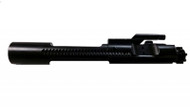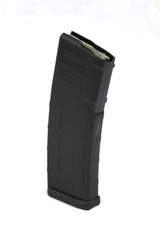
6.5 GRENDEL VS 6.8 SPC: THE COMPLETE GUIDE
The AR15 platform is perhaps the most versatile rifle in existence. Not only does this include an ever-expanding line of external parts and accessories including stocks, forends, optics, lights, and other paraphernalia, the very cartridge around which the rifle is based is variable. Hunters, soldiers, competitors, and tinkerers are always looking to improve on the ballistics of the platform.
Two such improved cartridges are the closely related 6.5 Grendel and 6.8 SPC. These cartridges have a lot in common, and both deliver a heavier bullet than the 5.56, resulting in over 40% more energy to the target. But is one better for you? This article will explore the differences between the two.
A Brief History of 6.5 Grendel and the 6.8 SPC
The 6.5 Grendel cartridge is one such attempt to elevate America's Rifle. The Grendel was unveiled in 2003, the brainchild of Bill Alexander (who can also lay claim to the .50 Beowulf). Ballistics were intended to best the 5.56x45 NATO, and they easily did so. In fact, the early 6.5 offerings gave the .308 Winchester a run for its money, shooting flatter and staying supersonic longer. All this while still fitting in a standard AR15 platform and utilizing a STANAG magazine. Since its SAAMI standardization in 2010, it has become one of the top "alternative" AR chamberings.
Meanwhile, from 2002-2004 the 6.8 Remington Special Purpose Cartridge (SPC) was under development. Rather than a visionary wildcatter, this cartridge was designed by Remington Arms with input from the Army Marksmanship Unit and the U.S. Special Operations Command (USSOCOM). It was designed to address failings of the 5.56 cartridge out of shorter-barreled M4 carbines while still operating in the same-sized platform and legitimized by SAAMI in 2004. The cartridge reportedly performed well at close range but was shelved by the military for a variety of reasons.
While neither cartridge was adopted in any significant numbers by the military, they weren't forgotten, either. Both hung on and both are perhaps more popular today than they were ten years ago. For the record, neither intermediate cartridge is confined to the AR-15 platform, and both would make fine short-action bolt-action cartridges, too. Let's take a look at these two cartridges and see what the differences between them really are.
The 6.5 Grendel vs. 6.8 SPC
Both the 6.5 Grendel and 6.8 SPC cartridges have some similarities. They function out of the same platform size as the 5.56 AR. This means that a barrel and a bolt are all you typically need to swap to make the magic happen with one of these two cartridges, though swapping a complete upper is generally a better course of action.
Both cartridges will also fit in a standard, STANAG AR15 magazine. I said they will fit, not that they will necessarily function. They might, but both cartridges have different geometry than the 5.56. This can cause them to stack differently in the magazine. It would be a good idea to purchase purpose-built magazines for the caliber you're shooting, at least until you prove standard mags reliable in your platform.
Both cartridges also fill a niche, the happy medium between the .223/5.56x45 NATO and the .308 Winchester/7.62x51 NATO. Both offer external ballistics that seem to punch above the AR's weight class with greater magazine capacity, faster follow-ups, and less recoil.
Cartridge Specs
Both cartridges are 2.26" in length, the maximum allowable length for the AR platform. The 6.5 Grendel has a bullet diameter of .264 inches. The Grendel's most common bullet weight is 123-grains, with other bullets available as light as 90 and as heavy as 130 grains. The 6.8 SPC fires a .277-caliber bullet weight ranging from 75-120 grains.
Grendel ammo is loaded into a wider case with less overall case length. The base diameter of the case is 0.439" versus the 0.422" base diameter of the 6.8 SPC. This gives the 6.8 SPC slightly more overall case capacity while keeping the case a bit slimmer but at the disadvantage of requiring the use of stubbier bullets that aren't quite as effective at longer ranges.
Muzzle Velocity & Kinetic Energy
From barrels of the same length, the Grendel and SPC cartridges perform similarly. The 6.5 really shines at longer ranges, however. With a shorter case length, it utilizes longer bullets, giving it a higher ballistic coefficient. The 6.5 Grendel was designed to be fired from a minimum barrel length of 20 inches. While it can be fired from shorter tubes it tends to lose a lot of its potential.
When fired from the longer barrels it was optimized for, the 6.5 Grendel with its higher ballistic coefficient, offers a flatter trajectory than the 6.8 SPC. This difference tends to become greater as the distance increases, and the skinny 6.5 bullets are also much less susceptible to wind drift than the wider 6.8 bullets. If your intent is to shoot beyond, say, 600 yards the Grendel is probably your best bet, though these differences are pretty slight.
On the other hand, the 6.8 SPC was designed to be shot from shorter, 14.5" barrels of military M4s. From the muzzle the 6.8 SPC offers greater velocity and greater kinetic energy than the Grendel from shorter, 16" barrels. If you desire a superior performance from a shorter barrel and your ranges are inside 600 yards the 6.8 SPC is definitely a contender.
Recoil
Most experienced adult shooters will find neither cartridge has punishing recoil. Both have more recoil than 5.56, yet both are extremely manageable. That said, the Grendel cartridge does have more felt recoil than the 6.8 SPC. Again, neither is painful or difficult to control, but this is another feather in the quiver of the 6.8 SPC being the preferred close quarters round.
Moderate amounts of recoil reduction can be easy to overlook by experienced shooters. A little less recoil can make a big difference to kids or the recoil sensitive. The 6.8 SPC's lower recoil might be important to a kid on his first deer hunt. In these instances, long-distance shooting is rarely the priority, but accuracy always is. A little less recoil can go a long way.
Practical Applications
Both of these cartridges offer plenty of practical applications. Since both chamber in traditional, AR-platform rifles, they make excellent candidates for a ballistically-upgraded AR. Both the 6.5 Grendel and the 6.8 SPC offer at least 40% more power than the 5.56. As we have seen, the 6.8 delivers a slight advantage up-close and the 6.5 performs slightly better at distance.
Both offer a serious lethality upgrade. Though gaining favor, the 5.56 has been somewhat debatable as a hunting round. Heavier, larger-diameter bullets that both the 6.5 and 6.8 cartridges have are probably better suited to hunters of medium, thin-skinned game. While not quite at traditional, .30-caliber hunting load energy levels, these cartridges pack plenty of power for clean kills on mule deer, feral hogs, and similarly sized game.
Both would also be inherently practical for self-defense applications. Again, the ballistic superiority of the two over 5.56 at close range is undeniable. It is easy to imagine law enforcement applications, as well. While performing well up close and personal, both perform pretty well at distances outside of typical self-defense ranges, but at ranges well within the realm of plausibility for LEOs.
One practical consideration is ammunition availability. The 6.5 seems to be more popular, and Grendel ammo is more readily available on the market than 6.8 SPC loadings. Of course, this only applies if one is limited to factory ammo for one reason or another (LE or defensive use coming to mind). If one reloads, the sky is the limit.
The Bottom Line
There are some differences between these cartridges. An easy way to think about is the 6.8 SPC hard-hitting terminal performance at close range, while the 6.5 Grendel has longer legs and retains good energy for much longer. If you need the longer range, the 6.5 is your best bet, and if you want a cartridge that performs optimally from a shorter barrel, go with the 6.8 SPC. Really though, the differences are pretty small for about 99% of hunters and shooters out there, so you probably won't go wrong with either.
The SOTA Arms Difference
The AR15 is a tremendously versatile rifle. Part of that versatility is the ability to utilize the right cartridge for the job. The 5.56 isn't the answer for everything. If you need to get more power out of your existing platform, you may consider moving up in caliber to a 6.5 Grendel or 6.8 SPC. SOTA Arms offers everything you need to step up to a bigger-bore AR. As a side note, the feedback Sota Arms gets from it’s customers is the 6.8 shoots very well out to 600 yards and and with the 6.8 Grendel, out to 1,000 yards.
The differences between both of these cartridges are pretty small. For what 99% of hunters need either will answer the mail. Regardless of which caliber you choose, SOTA Arms offers complete uppers in both 6.5 Grendel and 6.8 SPC. Both of these are in the "correct" barrel length, with most Grendel offerings with a longer barrel of 20 inches. The 6.8 offerings all come with the 16-inch barrel from which the 6.8 performs best. A wide variety of options are available including black or naked stainless barrels and Key-Mod and M-LOK handguards.
If a complete upper isn't your thing and you want to completely re-chamber your rifle, SOTA has got your back. Both the 6.5 and 6.8 only require a barrel, bolt carrier group, and magazines to change calibers, and we carry top-of-the-line versions of all three. If you decide neither the 6.5 Grendel nor 6.8 SPC meets your needs, SOTA Arms carries uppers and upper parts in a variety of other chamberings, as well.








